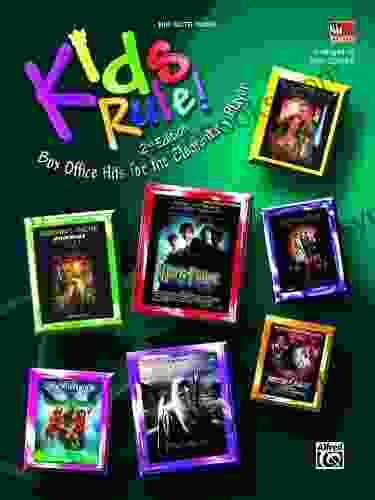How To Find The Sounds You Like

A Comprehensive Guide to Discovering Your Musical Preferences
Music is a powerful force that can evoke emotions, trigger memories, and connect people across cultures. But with so much music out there, it can be overwhelming to know where to start when it comes to finding music that you actually like.
4.4 out of 5
| Language | : | English |
| File size | : | 14789 KB |
| Text-to-Speech | : | Enabled |
| Enhanced typesetting | : | Enabled |
| Screen Reader | : | Supported |
| Print length | : | 192 pages |
That's where this guide comes in. We'll walk you through everything you need to know about discovering your musical preferences, from exploring different genres and artists to understanding your own listening habits and tastes.
Step 1: Explore Different Genres
The first step to finding the sounds you like is to explore different genres. There are dozens of genres out there, from rock and pop to classical and hip-hop. Each genre has its own unique sound, so it's important to listen to a variety of different genres to see what you like.
Here are a few of the most popular genres:
- Rock: Rock music is characterized by its strong beats, catchy melodies, and often-distorted guitars.
- Pop: Pop music is typically upbeat and catchy, with simple melodies and lyrics that are easy to sing along to.
- Classical: Classical music is known for its complex melodies, harmonies, and instrumentation.
- Hip-hop: Hip-hop music is characterized by its rapping, sampling, and often-political lyrics.
- Electronic: Electronic music is made using electronic instruments, such as synthesizers and drum machines.
These are just a few of the many genres out there. Don't be afraid to experiment and listen to different genres to see what you like.
Step 2: Discover New Artists
Once you've started to explore different genres, it's time to start discovering new artists. There are millions of artists out there, so it can be hard to know where to start.
Here are a few tips for finding new artists:
- Listen to recommendations from friends and family. If you know someone who has similar musical tastes to you, ask them for recommendations.
- Check out music blogs and websites. There are many websites and blogs that review new music and artists.
- Go to concerts and live music events. This is a great way to discover new artists and see them perform live.
Once you've found a few new artists that you like, take some time to listen to their music and learn more about them.
Step 3: Understand Your Listening Habits and Tastes
As you listen to more and more music, you'll start to develop your own unique listening habits and tastes.
Here are a few things to consider:
- What do you like to listen to? Do you prefer upbeat music or mellow music? Do you like music with lyrics or without lyrics?
- When do you like to listen to music? Do you like to listen to music while you're working out, studying, or relaxing?
- What are your favorite songs? What do you like about these songs? Is it the melody, the lyrics, the beat, or the overall sound?
The more you understand your own listening habits and tastes, the easier it will be to find music that you like.
Step 4: Refine Your Search
Once you have a better understanding of your musical preferences, you can start to refine your search for new music.
Here are a few tips:
- Use music streaming services. Most music streaming services offer personalized recommendations based on your listening history.
- Read music reviews. Music reviews can give you a good idea of what other people think of an album or artist.
- Ask for recommendations from music experts. If you know someone who is knowledgeable about music, ask them for recommendations.
With a little effort, you can find music that you love and that perfectly matches your unique tastes.
Finding the sounds you like is a journey of exploration and discovery. By following these steps, you can uncover your own unique musical identity and find music that you truly enjoy.
So what are you waiting for? Start exploring today!
4.4 out of 5
| Language | : | English |
| File size | : | 14789 KB |
| Text-to-Speech | : | Enabled |
| Enhanced typesetting | : | Enabled |
| Screen Reader | : | Supported |
| Print length | : | 192 pages |
Do you want to contribute by writing guest posts on this blog?
Please contact us and send us a resume of previous articles that you have written.
 Book
Book Novel
Novel Page
Page Chapter
Chapter Text
Text Story
Story Genre
Genre Reader
Reader Library
Library Paperback
Paperback E-book
E-book Magazine
Magazine Newspaper
Newspaper Paragraph
Paragraph Sentence
Sentence Bookmark
Bookmark Shelf
Shelf Glossary
Glossary Bibliography
Bibliography Foreword
Foreword Preface
Preface Synopsis
Synopsis Annotation
Annotation Footnote
Footnote Manuscript
Manuscript Scroll
Scroll Codex
Codex Tome
Tome Bestseller
Bestseller Classics
Classics Library card
Library card Narrative
Narrative Biography
Biography Autobiography
Autobiography Memoir
Memoir Reference
Reference Encyclopedia
Encyclopedia Cristina Morales
Cristina Morales Damion Hunter
Damion Hunter Dorothea Lasky
Dorothea Lasky Kevin Mungons
Kevin Mungons Kathy Allen
Kathy Allen Michelle Zimmerman
Michelle Zimmerman Clint Lorance
Clint Lorance Clifford R Murphy
Clifford R Murphy Dale Mayer
Dale Mayer Yrsa Daley Ward
Yrsa Daley Ward Edward T O Donnell
Edward T O Donnell D M Andrews
D M Andrews Joan Williams
Joan Williams Eleanor Clark
Eleanor Clark Raia Prokhovnik
Raia Prokhovnik Claudia Ulloa Donoso
Claudia Ulloa Donoso Kindle Edition With Audio Video
Kindle Edition With Audio Video Damian Barr
Damian Barr Cole Baxter
Cole Baxter Donovan Livingston
Donovan Livingston
Light bulbAdvertise smarter! Our strategic ad space ensures maximum exposure. Reserve your spot today!
 Gene SimmonsFollow ·11k
Gene SimmonsFollow ·11k Darrell PowellFollow ·2.4k
Darrell PowellFollow ·2.4k William ShakespeareFollow ·16.7k
William ShakespeareFollow ·16.7k Hector BlairFollow ·18.5k
Hector BlairFollow ·18.5k Jorge Luis BorgesFollow ·10.1k
Jorge Luis BorgesFollow ·10.1k Andy HayesFollow ·3.2k
Andy HayesFollow ·3.2k Ervin BellFollow ·5.4k
Ervin BellFollow ·5.4k Connor MitchellFollow ·18.5k
Connor MitchellFollow ·18.5k

 Cooper Bell
Cooper BellKids Rule Box Office Hits for the Elementary Player
Empowering Young Performers:...

 Gabriel Blair
Gabriel BlairUnraveling the Enigma: Political Alienation and Its...
In the labyrinthine tapestry of human...

 Anthony Burgess
Anthony BurgessBe a Great Singer: Unleash Your Musical Talent with...
Do you dream of singing with...

 Heath Powell
Heath PowellDive into a Musical Masterpiece: "10 for 10 Sheet Music...
An Enchanting Journey Through Broadway...

 Guy Powell
Guy PowellUniversal Rights, Systemic Violations, and Cultural...
The notion of universal human rights is a...
4.4 out of 5
| Language | : | English |
| File size | : | 14789 KB |
| Text-to-Speech | : | Enabled |
| Enhanced typesetting | : | Enabled |
| Screen Reader | : | Supported |
| Print length | : | 192 pages |














